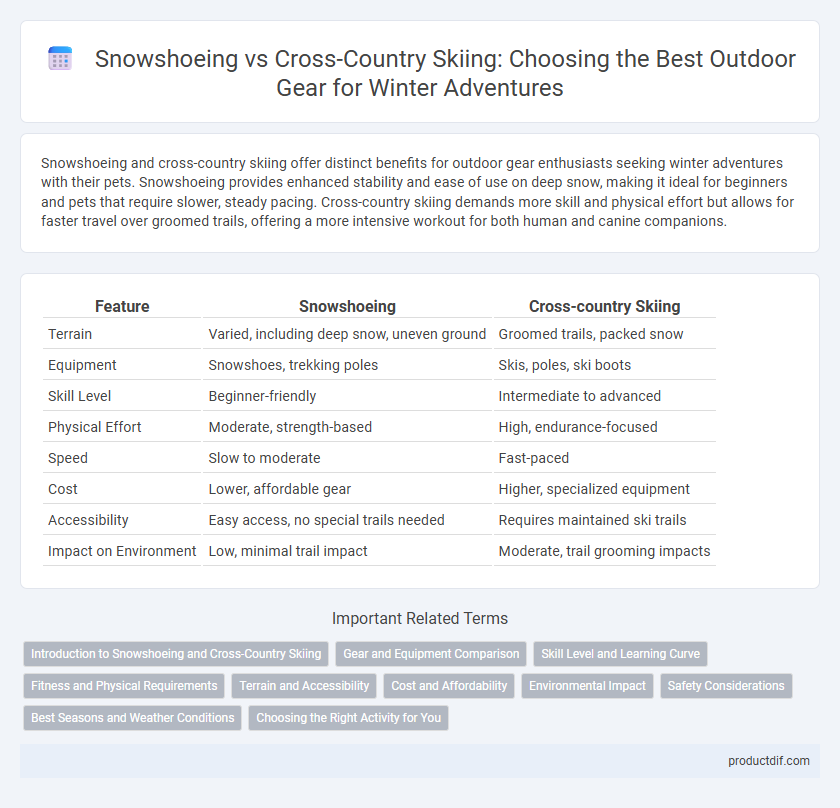Snowshoeing and cross-country skiing offer distinct benefits for outdoor gear enthusiasts seeking winter adventures with their pets. Snowshoeing provides enhanced stability and ease of use on deep snow, making it ideal for beginners and pets that require slower, steady pacing. Cross-country skiing demands more skill and physical effort but allows for faster travel over groomed trails, offering a more intensive workout for both human and canine companions.
Table of Comparison
| Feature | Snowshoeing | Cross-country Skiing |
|---|---|---|
| Terrain | Varied, including deep snow, uneven ground | Groomed trails, packed snow |
| Equipment | Snowshoes, trekking poles | Skis, poles, ski boots |
| Skill Level | Beginner-friendly | Intermediate to advanced |
| Physical Effort | Moderate, strength-based | High, endurance-focused |
| Speed | Slow to moderate | Fast-paced |
| Cost | Lower, affordable gear | Higher, specialized equipment |
| Accessibility | Easy access, no special trails needed | Requires maintained ski trails |
| Impact on Environment | Low, minimal trail impact | Moderate, trail grooming impacts |
Introduction to Snowshoeing and Cross-Country Skiing
Snowshoeing offers a low-impact, accessible way to explore snowy landscapes using lightweight frames that distribute weight over soft snow, making it ideal for beginners and rugged terrains. Cross-country skiing combines cardiovascular exercise with gliding motion on skis designed for groomed trails or backcountry routes, enhancing endurance and balance. Both activities require specialized outdoor gear such as insulated clothing, waterproof boots, and weather-resistant accessories to ensure safety and comfort in winter conditions.
Gear and Equipment Comparison
Snowshoeing requires lightweight, durable snowshoes with robust bindings and insulated boots for stability on deep snow, while cross-country skiing demands specialized skis with rigid boots and poles designed for gliding on groomed trails. Snowshoe gear is generally simpler and more affordable, focusing on traction and flotation, whereas cross-country ski equipment incorporates advanced materials like carbon fiber for performance and efficiency. Both sports benefit from moisture-wicking layers, but cross-country skiing gear often includes aerodynamic clothing and specialized wax or skins for ski bases to enhance glide.
Skill Level and Learning Curve
Snowshoeing requires minimal skill and features a gentle learning curve, making it accessible for beginners and casual hikers. Cross-country skiing demands better balance and coordination, often needing dedicated lessons to master technique and efficiency. While snowshoeing offers straightforward navigation across snow, cross-country skiing provides a faster, more dynamic workout for intermediate to advanced outdoor enthusiasts.
Fitness and Physical Requirements
Snowshoeing demands lower technical skills and primarily targets leg strength and cardiovascular endurance, making it accessible for beginners and those seeking moderate aerobic workouts. Cross-country skiing requires greater balance, coordination, and full-body engagement, significantly enhancing core strength, arm muscles, and cardiovascular fitness. Both activities offer effective calorie burning, but cross-country skiing typically provides a higher intensity workout with more complex motor skills.
Terrain and Accessibility
Snowshoeing excels on rugged, uneven terrains and deep snow where cross-country skiing may be challenging, making it highly accessible for beginners and diverse landscapes. Cross-country skiing requires groomed trails with packed snow to optimize glide and efficiency, which limits its accessibility in remote or off-trail areas. Both activities demand specialized gear, but snowshoeing's versatility in terrain makes it a preferred choice for exploring untouched backcountry regions.
Cost and Affordability
Snowshoeing offers a more budget-friendly option with basic snowshoes ranging from $50 to $150, while cross-country skiing equipment, including skis, boots, and poles, typically starts around $300 and can exceed $1,000 for high-end gear. Maintenance and trail pass fees for cross-country skiing can also add to the overall cost, whereas snowshoeing generally requires minimal upkeep and no trail fees. Choosing snowshoeing can significantly reduce initial and ongoing expenses, making it accessible for budget-conscious outdoor enthusiasts.
Environmental Impact
Snowshoeing generally has a lower environmental impact compared to cross-country skiing due to less reliance on specialized grooming equipment and infrastructure. Snowshoeing minimizes soil and vegetation disturbance by allowing users to walk over fragile snow-covered terrain without compacting it deeply. Cross-country skiing often requires trail grooming and frequent maintenance, which can contribute to greater energy consumption and habitat disruption.
Safety Considerations
Snowshoeing offers greater stability on uneven terrain, reducing the risk of falls compared to cross-country skiing, which demands better balance and technique. Proper safety gear such as avalanche beacons, helmets, and layered clothing is essential for both activities in remote or snowy environments. Understanding avalanche risks and weather conditions is critical to ensure safe outings when snowshoeing or cross-country skiing in backcountry areas.
Best Seasons and Weather Conditions
Snowshoeing excels in deep, powdery snow and can be enjoyed in colder, wetter winter conditions, making it ideal for late winter and early spring when snow accumulates heavily. Cross-country skiing performs best on groomed trails with compact, dry snow typically found in mid-winter months when temperatures remain below freezing but not excessively cold. Both activities thrive in calm weather, but snowshoeing is more versatile in variable weather, while cross-country skiing requires stable, firm snow for optimal glide.
Choosing the Right Activity for You
Snowshoeing offers an accessible and low-impact way to explore snowy terrains, ideal for beginners or those seeking a slower pace with minimal equipment. Cross-country skiing demands more skill and endurance, providing a full-body workout and faster travel over groomed trails, suited for fitness enthusiasts and adventure seekers. Consider factors like fitness level, terrain preference, and desired intensity to choose the activity that best matches your outdoor goals.
Snowshoeing vs Cross-country skiing Infographic

 productdif.com
productdif.com